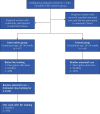Effect of antenatal class attendance on fear of childbirth and antenatal stress
- PMID: 37075401
- PMCID: PMC10118411
- DOI: 10.11606/s1518-8787.2023057004272
Effect of antenatal class attendance on fear of childbirth and antenatal stress
Abstract
Objective: To assess the effect of attending antenatal classes on fear of childbirth and antenatal stress in nulliparous pregnant women.
Methods: A total of 133 nulliparous pregnant women participated in the study, which had a quasi-experimental design. Data were collected by a descriptive data form, the Wijma Delivery Expectancy/Experience Questionnaire, and the Antenatal Perceived Stress Inventory (APSI).
Results: A significant correlation was found between antenatal class attendance and having a high schooling level and an intended pregnancy (p < 0.05). The mean fear of childbirth score of pregnant women was 85.50 ± 19.41 before the training and 76.32 ± 20.52 after the training, and the difference between these scores was significant (p < 0.01). Fear of childbirth score were not significantly different between the intervention group and the control group. The mean APSI score of pregnant women in the intervention group was 22.32 ± 6.12 before the training and 21.79 ± 5.97 after the training. However, this difference was not statistically significant (p = 0.70).
Conclusion: The fear of childbirth score decreased significantly in the intervention group after the training.
Conflict of interest statement
Conflict of Interest: The authors declare no conflict of interest.
Similar articles
-
Does antenatal education reduce fear of childbirth?Int Nurs Rev. 2016 Mar;63(1):60-7. doi: 10.1111/inr.12223. Epub 2015 Nov 27. Int Nurs Rev. 2016. PMID: 26612181
-
The relationship between personality characteristics and fear of childbirth: A descriptive study.Arch Psychiatr Nurs. 2021 Jun;35(3):296-302. doi: 10.1016/j.apnu.2020.09.018. Epub 2020 Nov 28. Arch Psychiatr Nurs. 2021. PMID: 33966796
-
The effects of antenatal education on fear of childbirth, maternal self-efficacy and post-traumatic stress disorder (PTSD) symptoms following childbirth: an experimental study.Appl Nurs Res. 2016 Nov;32:227-232. doi: 10.1016/j.apnr.2016.07.013. Epub 2016 Jul 30. Appl Nurs Res. 2016. PMID: 27969033
-
Predictors of prenatal distress and fear of childbirth among nulliparous and parous women.Niger J Clin Pract. 2019 Dec;22(12):1635-1643. doi: 10.4103/njcp.njcp_613_18. Niger J Clin Pract. 2019. PMID: 31793468
-
Interventions for fear of childbirth including tocophobia.Cochrane Database Syst Rev. 2021 Jul 7;7(7):CD013321. doi: 10.1002/14651858.CD013321.pub2. Cochrane Database Syst Rev. 2021. PMID: 34231203 Free PMC article.
Cited by
-
The relationship between fear of birth and prenatal attachment and childbirth self-efficacy perception in Primigravida women.BMC Pregnancy Childbirth. 2025 Apr 21;25(1):462. doi: 10.1186/s12884-025-07555-7. BMC Pregnancy Childbirth. 2025. PMID: 40259226 Free PMC article.
References
-
- Klabbers GA, JAvB Hedwig, MAvdH Marit, Vingerhoets AJJM. Severe fear of childbirth: its features, assesment, prevalence, determinants, consequences and possible treatments. Psychol Top . 2016;25(1):107–127.
-
- Rondung E, Thomten J, Sundin O. Psychological perspectives on fear of childbirth. J Anxiety Disord . 2016;44:80–91. - PubMed
MeSH terms
LinkOut - more resources
Full Text Sources


